#miss bernburg's finishing school for young ladies
Note
🌀,🌤️,and 🌈 please!

🌀 Post the pitch for a game you’re working on
I have to cheat a little for this one because my games are currently either done or such vague ideas that I can't even pitch them properly.
But let's talk about Bunny, We Bought a Dungeon, which Jasmin Neitzel and me actually wrote first before we hacked it into Dolly, We Bought a Dream House.
Here's the pitch: You're a group of anthropomorphic bunnies who have bought a dungeon to move in there together. As you narrate the exploration and renovation of the dungeon, you draw a map of it together.
Mechanically, we're calling it a GM-less OSR story game. We're using OSR elements like dice drops, random roll tables, and of course a classic fantasy dungeon setting and combine them with GM-less story mechanics, action rolls inspired by Lasers & Feelings (but not exactly like L&F), and the idea that dungeons can also be homes.
We've already published it in German earlier this year and I've recently translated it into English and will release it tomorrow at the latest.

🌤️ Share your favorite mechanic from a game you’re working on
Same disclaimer as above. So let's talk about something I've already published! I'm still proud of my supplement Alternative Crowns of the Queen for Brindlewood Bay.
As in the original game, it's a set of narrative prompts that allow more insight into the characters' backstory and current life outside of investigating murders and supernatural conspiracies (you use them to bump up a roll one level). And as in the original game, they're meant to show the Murder Mavens "as a woman."
However, my Crowns of the Queen cover a lot more ground than the ones in the original because a senior woman's life of course contains many other relevant aspects than being a daughter, mother, or wife/romantic partner (which is what the original game focuses on). Therefore, my Crowns offer you prompts about bodies, aging, and health, female solidarity and friendship, professional successes and failures, and of course an option to tell a coming-out story.
(In case anyone reading along is wondering: Yes, I absolutely think asking questions/giving narrative prompts is a proper game mechanic just as much as rolling dice or drawing cards or ticking boxes on a sheet is.)

🌈 Share your favourite class/playbook from one of your games (name the game, or let me choose)
So far, I only have one game that has something resembling playbooks, so we're talking about my Firebrands game Miss Bernburg's Finishing School for Young Ladies here. It's set in an all-girl upper-class boarding school in the 1950s (located in Western Europe or North America).
It has three cliques to choose from, which function as character archetypes more than social circles: Homemakers, Bookworms, and Rebels (the latter may be renamed in the translation of the second edition I'm planning for sometime in the future). You get a short flavor text, a list of attractive characteristics to choose three from, and some name suggestions. There are further character questions to answer, such as items they've put on display or keep hidden in their dorm rooms (those are partly different in the first and second edition of the game).
I always enjoy playing a Homemaker (or seeing them played) because there's so much variety you can bring to this type of Young Lady. You can play her as a naive, down-to-earth person who just enjoys traditionally female activities and responsibilities. Or you can play her as a charmingly manipulative person who sees this role as the best opportunity to at least have some social and political influence in her life. Or you can play her as someone who aims to use a facade of respectability to create space for a relatively unbothered queer life on the side. Or maybe she's just waiting for someone to nudge her out of her conformist comfort zone and discover a curious or rebellious streak?
As always, we play to find out, and the Homemakers nearly always have some of the most interesting story arcs I've played and witnessed in this game. (Ask me again and I will tell you the same thing about the other two cliques, though!)
(Cover illustration by Christiane Ebrecht)
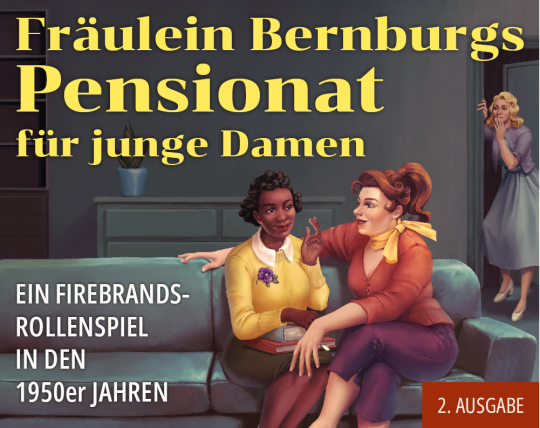
Thanks for asking! 💖
#my games#plotbunny games#ttrpg design#ask me stuff#bunny we bought a dungeon#alternative crowns of the queen#brindlewood bay#miss bernburg's finishing school for young ladies#fräulein bernburgs pensionat für junge damen
3 notes
·
View notes
Text
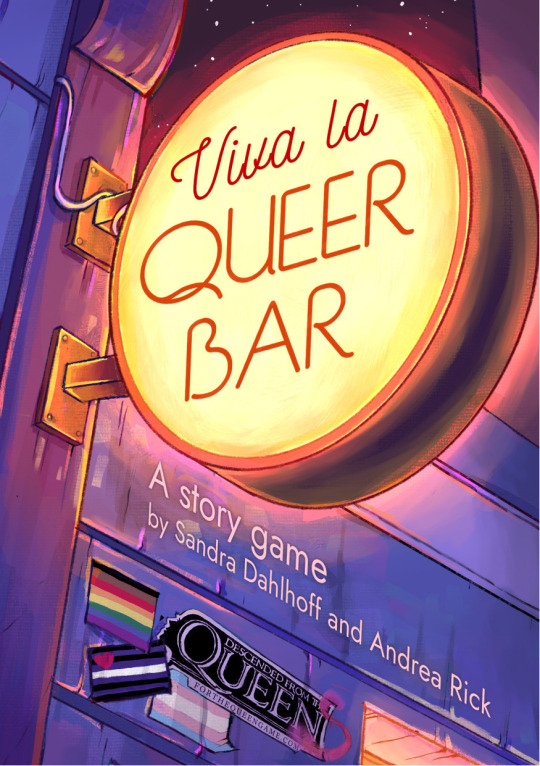
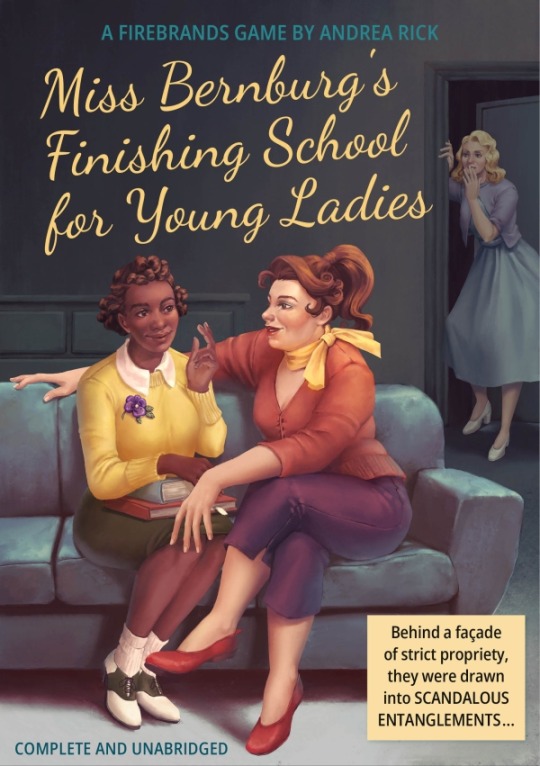

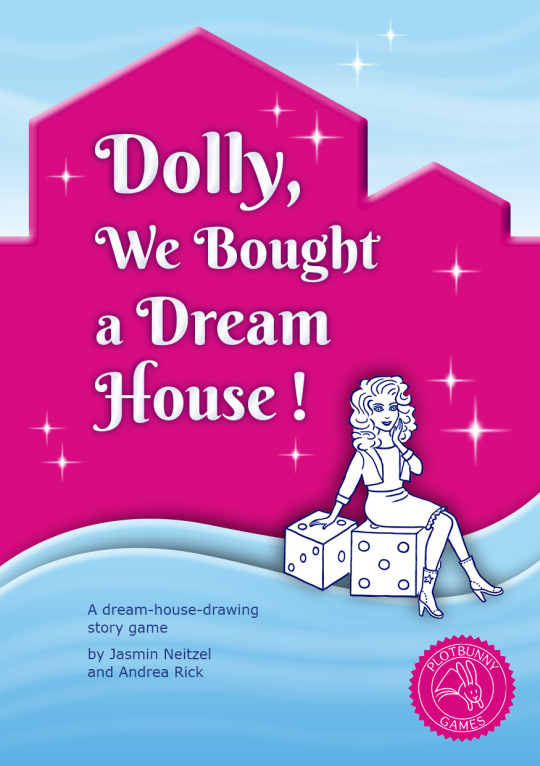


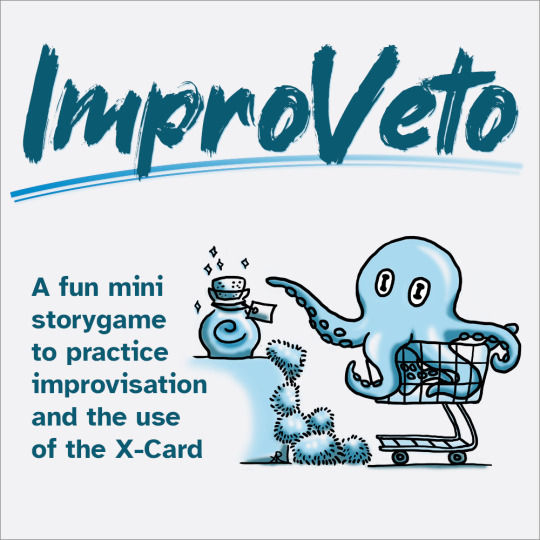
I thought I'd post a reminder of all the games you can get through us!
Viva la QueerBar is a story game about a queer bar and the team who runs it. GM-less one-shot for 2-6 players, Descended from the Queen mechanics. Written by Sandra Dahlhoff and Andrea Rick, cover art by Hannah van den Höövel.
Miss Bernburg's Finishing School for Young Ladies is a story game about the interpersonal drama at a boarding school for upper-class young women in the 1950s. GM-less one-shot or few-shot for 3-6 players, Firebrands mechanics. Written by Andrea Rick, cover art by Christiane Ebrecht.
Bunny, We Bought a Dungeon is an OSR map-drawing story game about anthropomorphic bunnies who bought a dungeon to move in there together. GM-less one-shot for 2-6 players, D6 dice pool mechanic. Written by Jasmin Neitzel and Andrea Rick, cover art from the Public Domain.
Dolly, We Bought a Dream House is a dream-house-drawing story game about Dollys in a pinktastic world who explore and furnish a Dream House together. GM-less one-shot for 2-6 players, D6 dice pool mechanic. Written by Jasmin Neitzel and Andrea Rick, cover art by Andrea Rick.
Magical Pets is a narrative TTRPG about pets at a magic school. One-shot or mini campaign for 2-6 players and 1 GM, Lasers & Feelings hack. Writing and art by Andrea Rick.
Rodents With Guitars is a narrative TTRPG about a group of rodents who want to win a guitar band contest. One-shot or mini campaign for 2-6 players and 1 GM, Honey Heist hack. Writing and art by Andrea Rick.
ImproVeto is a story game to practice collaborative storytelling (usually fun and absurd ones) and using the X-card. Warm-up or one-shot of 10-90 minutes, minimal mechanics. Writing and art by Andrea Rick.
---
We've also published the official German translation of Follow by Ben Robbins and are currently working on further translations into German (including Dream Askew/Dream Apart by Avery Alder and Benjamin Rosenbaum).
We'll be crowdfunding our next bilingual game Against the Monster/Gegen das Monster in February 2024 (separate post to come!).
You can buy all the games shown in this post through our website (most of them are available in print and PDF). Digital versions (all screenreader-ready with image descriptions, PDF tags, etc.) and more detailed descriptions in English are also available on Itch.io.
#ttrpg#indie ttrpg#plotbunny games#viva la queerbar#miss bernburg's finishing school#bunny we bought a dungeon#dolly we bought a dream house#magical pets#rodents with guitars#viva la queer bar#story games#frlbernburgs#followrpg
18 notes
·
View notes
Note
💡and/or✨for the ttrpg hype ask game?
💡 A game that inspired my own design or creative practice.
I'll go at this a little sideways and say that I keep being inspired by Our Haunt by Rae Nedjadi (a game about a found family of ghosts who live together in a house and need to figure out whether to recover their memories or make new ones instead).
Because that is one extremely well-explained game and I keep coming back to it to figure out just HOW Rae has made it so accessible, so inviting, and in such a gentle tone at that. Without ever feeling patronizing, the game reassures you that you'll be okay however you play (while still providing tips for getting the most out of it), gives you examples (the ongoing example of play is one of the best I've EVER read), suggests social scripts and wordings for those of us who find them helpful, and basically teaches you how to be a good player in a GM-less game (not just this one). It's endlessly encouraging and friendly, and it never veers into the kind of poisonous sweetness that makes me recoil elsewhere. It constantly lets you know that is has thought of your needs, your need for a break, for someone else's ideas, for space to imagine, for permission to interrupt others with enthusiasm without taking their words away from them.
It's always poetic and clear, and it makes you feel safe and brave at the same time (because you need safety to grow bravery - and you can use bravery to create safety). And it still never lets you forget that there's always sadness woven through our joy and always joy to find glimmering within our sadness.
You read Rae's explanations and not only do you understand the facts about his game, you also FEEL things as a person who might play it, you know?
I'm referencing Out Haunt directly as an influence in my German-only-so-far second edition of Fräulein Bernburgs Pensionat für junge Damen (Miss Bernburg's Finishing School for Young Ladies). I couldn't have written the examples in my chapter on setting up the game, nor my own example of play, nor the troubleshooting chapter the way I did without reading Our Haunt before.
I'm not sure if I'll ever manage to be that gentle and patient, but I'll keep trying. And I don't just mean in my game writing. Because really, all of this is never just about games. It's always also about us, the people who may play them with each other and the care we all deserve. And that is what I want to help create, not just with my games: Spaces where people care for each other. Spaces where people feel safe to ask questions, to express needs, and to wade a little deeper into creative vulnerability. 💖
✨ A game I wish more people were talking about.
One of this year's role-playing highlights was Midnight at the Oasis by Catherine Ramen (you can get it in Codex: Glamour on DriveThru).
It's a story game about a bar for crossdressing men in New York in the 1990s. On just 8 pages you get a fantastic, tightly-designed game in two acts and an epilogue. It comes with a handful of pre-made characters (which you'll flesh out with further details), all of whom are crossdressers with various backgrounds and from various age groups. The one exception is an "admirer" called Grant who can also be played (he's a sympathetic character at heart, but the other characters are still free to dislike him). The character questions during set-up are excellent and bring wonderful complications to the identities and relationships of these characters.
The game also gives you a bar map where every space comes with two options for a theme (such as "share a joy" and "confront a fear" for the dance floor) and some come with limitations what you can say there (you can only have a monologue in the bathroom). You can only interact with the characters sharing the same space in the bar (you can invite them to join you and they can either accept or refuse), and you're meant to explore the themes connected to the respective space. Like at an actual bar, you may miss a conversation at the bar while you're busy on the dance floor or vice versa, so no one can participate in everything, you always need to make choices, and you'll always miss out on other experiences.
The glossary on the last page of the game works almost like an oral history of terms and queer history (yes, I'm placing crossdressers, including heterosexual-identified ones, under the queer umbrella here on purpose - and in accordance with the game's author).
The heart of the game is the inevitable topic of transition that is brought into this bar on this particular night through the return of Dallas, a person who left the city a year ago to transition and is now back presenting male. The game clearly states that this detransition is temporary, and leaves it to the player of Dallas to define why it happened (which can remain secret) and the story of how it will be resolved is not part of the game.
It's a game about closets as safe spaces and safe spaces as closets, about choices, gender, desire (potentially), community, and how other people's identity impacts our own identity.
You don't need to be queer, trans, and/or a crossdresser to be able to play this game, but you need to be willing to play a crossdressing male character or someone who is attracted to such crossdressers.
I still haven't quite managed to put into words WHY this game is so great, but I highly recommend it and would love to see more people talk about it!
#ask me stuff#ttrpg#our haunt#rae nedjadi#midnight at the oasis#catherine ramen#games and the rest of life#queer stuff
6 notes
·
View notes